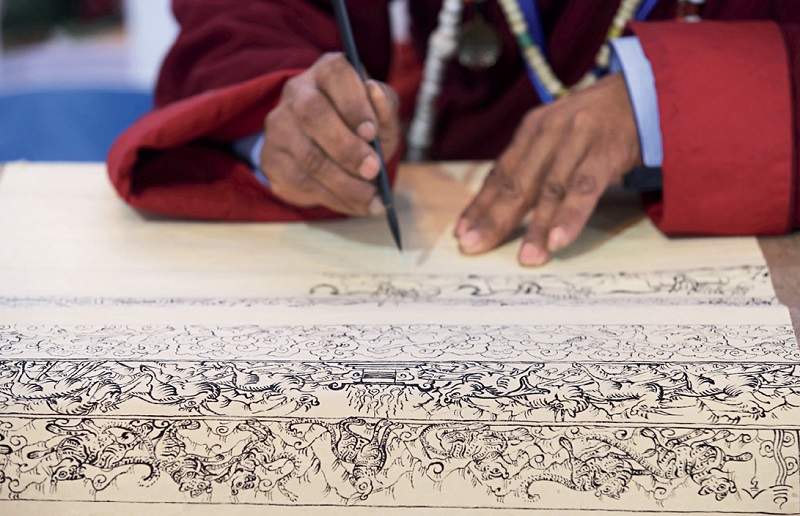
A man is drawing an exquisite Naxi Dongba painting.
Naxi Dongba painting is a painting style that has been passed down among the Naxi ethnic group living in the Hengduan Mountains along the Jinsha River at the borders of southwest China’s Yunnan, Sichuan, and Tibet. This art is popular in the Naxi communities in Lijiang City, Yunnan Province.
Dongba painting is usually used in the sacrificial practices of the Dongba religion. “Dongba” means “priest” in the Naxi language. The skills used in Dongba painting have been passed down and developed by generations of Dongba for several thousand years. Dongba painting is an embodiment of the Dongba culture exhibiting many aspects of Naxi folk customs, religion, astronomy, legislation, philosophy, geography, medicine, production knowledge, and so on. It is also considered a fine means of studying ancient art forms of painting. In 2006, the Naxi Dongba painting was added to China’s list of national intangible cultural heritage items.
Dongba paintings can be classified into wood painting, paper painting, and scroll painting, which are respectively drawn on wooden strips, Dongba paper, and burlap. Painters use tools made of bamboo, bronze, bone, ears of broomcorn, or wormwood stalk to paint an array of natural colors. The pigments used in Dongba paintings are extracted from rocks and plants by means of old methods which have been preserved for hundreds of years. Most paintings use three primary colors that are dazzling bright, presenting a stark visual contrast.
The art style portrayed in Dongba painting accentuates lines. Even when depicting complex subjects, Dongba artists can still create a vivid depiction of motions and textures. Since the themes illustrated in these paintings are often based in primitive religion, achieving realistic dimensions is not a priority. However, images of deity, demons, animals, plants, and figures are all painted very lifelike. Calligraphy-like patterns is a major feature of Dongba paintings.
A representative piece of Dongba painting is the scroll painting Shenlutu (Divine Path). It is an approximately 45-centimeter-wide and 20-meter-long comic strip composed of over 100 panels displaying around 365 figures and animals. The painting displays the worldviews of the Naxi people regarding the immortal spirit and understandings of human life.
To protect the Dongba painting culture, its inheritors pass on their knowledge of the painting techniques to students. In addition, Dongba paintings are also widely used in activities during Naxi’s traditional festivals, ceremonies, and religious rituals to add festive vibes. Today, Dongba paintings can be viewed in Naxi villages, the museum displaying Lijiang’s Dongba culture in the northern part of the old city of Lijiang, and other exhibitions, displaying the unique charm and cultural values of this ancient type of painting.